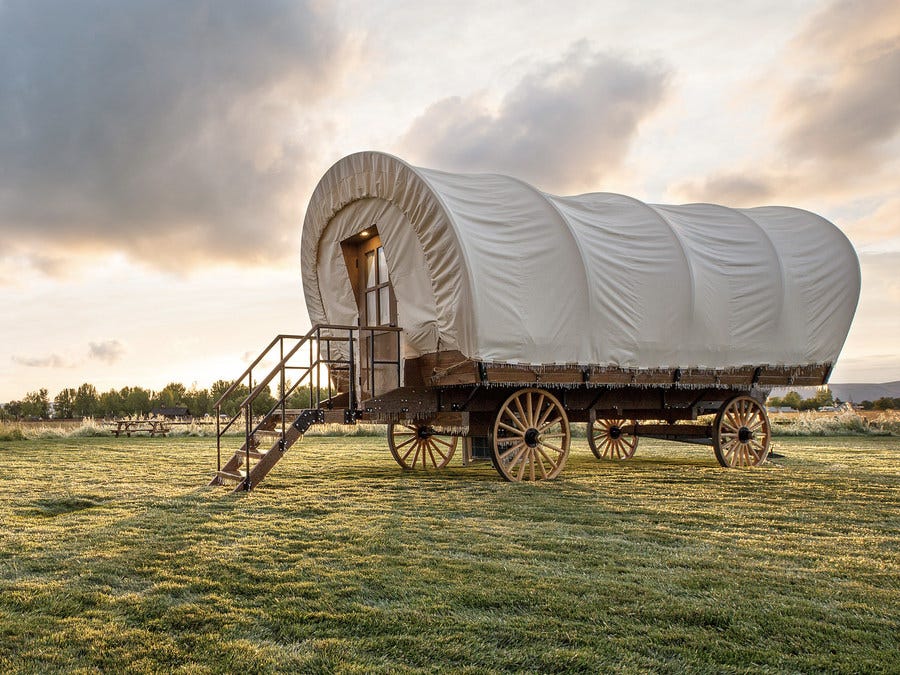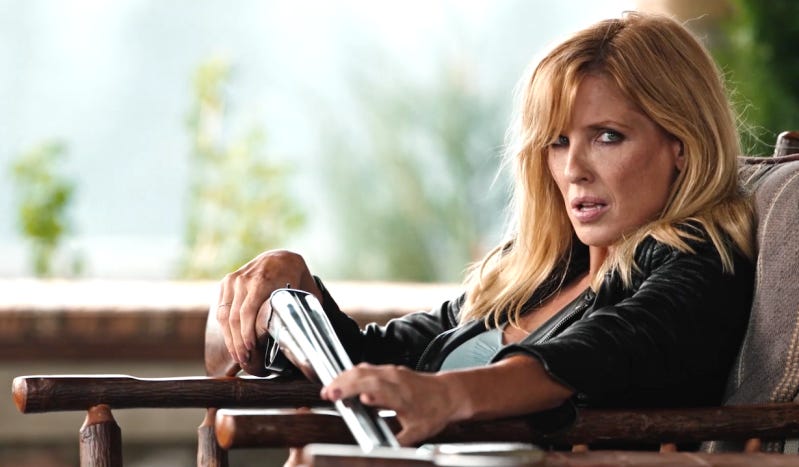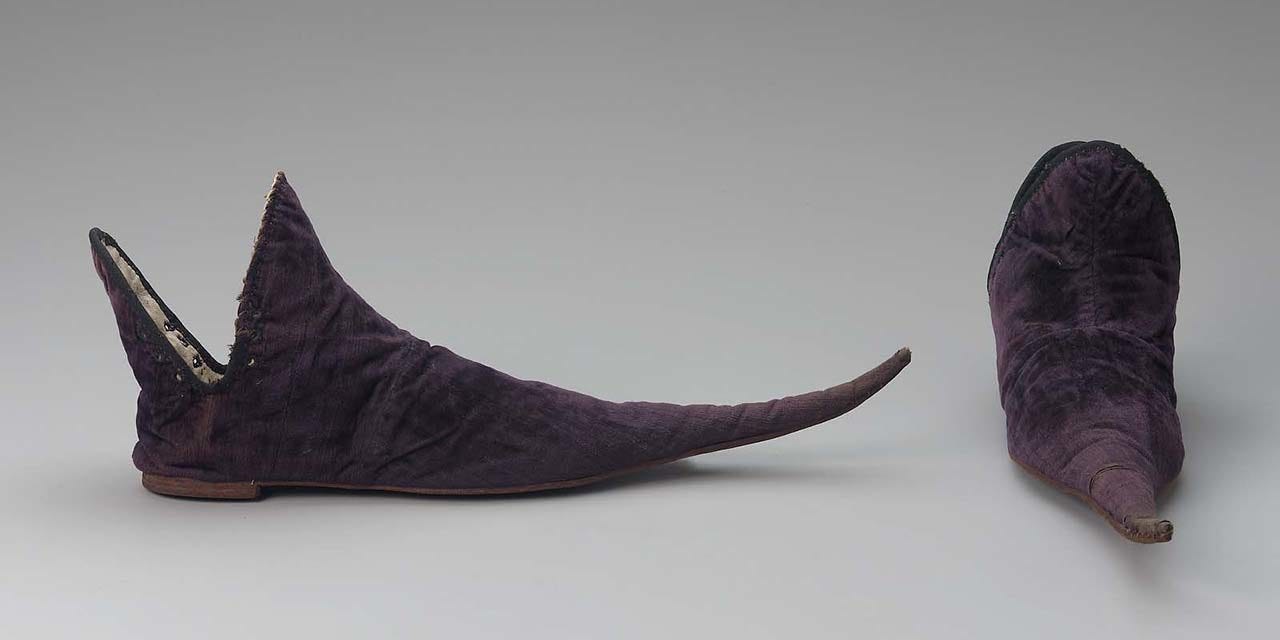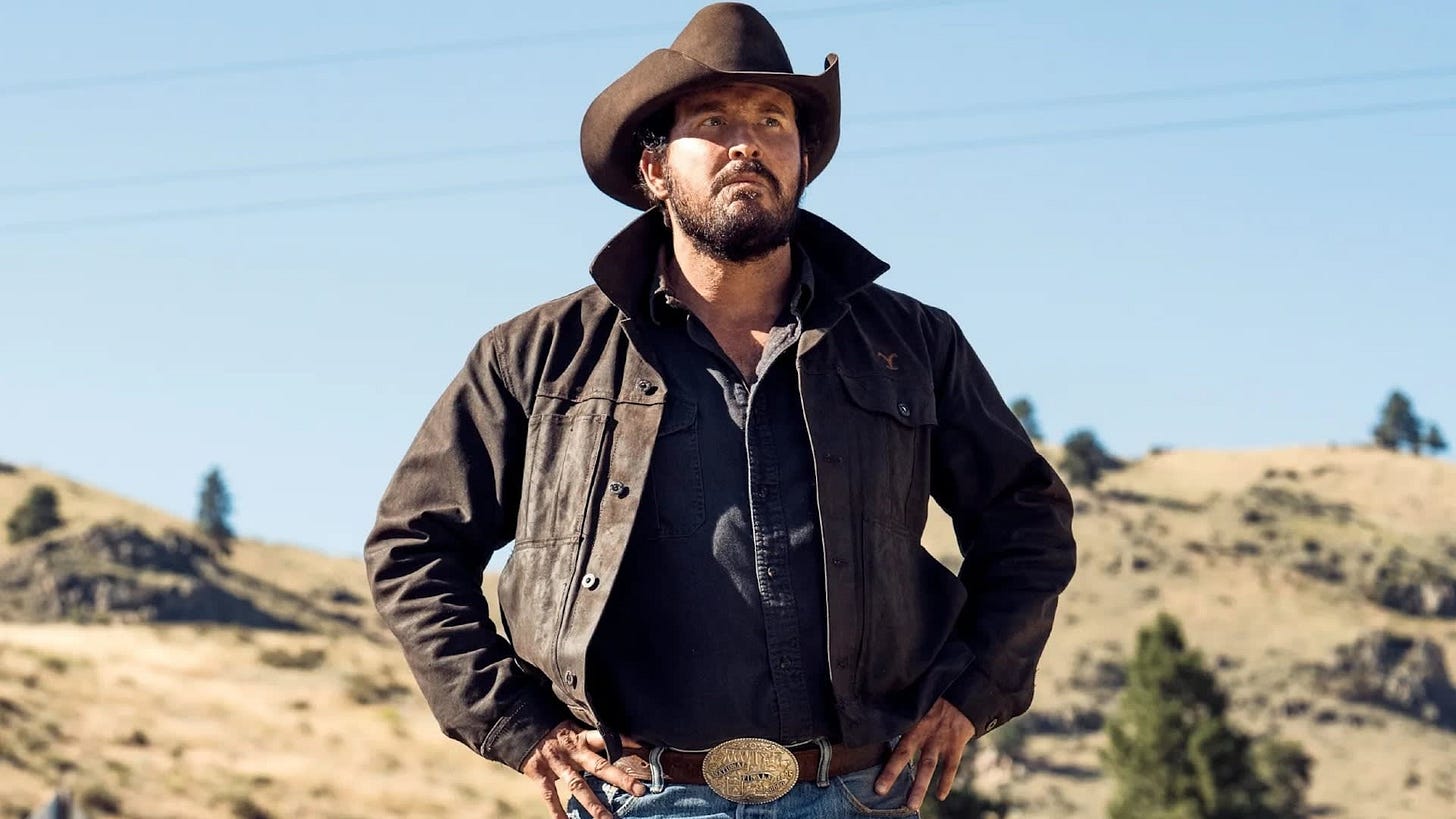What cowboys teach us about capitalism
An investigation into why Yellowstone, a show with no real plot, has struck such a chord.
The Business of Stuff is back, but with a new haircut. Before the summer, it was short, regular and business-y. This autumn, we’re growing it out a bit, seeing what works. First up is an essay on the appeal of Yellowstone. I hope you enjoy - there aren’t any spoilers.
Introduction
I rarely get hooked on a series. I have a short attention span and a pervasive sense of guilt every time I sit down midweek to watch something. That makes finishing five seasons of Yellowstone this year something of an achievement.
I’ve been struggling to work out what exactly it is that has resonated with me. Mainly because it’s definitely not the writing, which takes so much artistic licence that it then loses its licence and evades capture for five seasons whilst committing a string of felonies against credulity. Taylor Sheridan (the writer) himself has said it doesn’t really have a plot aside from the ongoing battle of “don’t take my land, I want your land”. Critics have panned it but it is and will remain an audience favourite. Why is this?
Join me on a journey through the American West, my own brain and capitalism to try and find out what is so great about Yellowstone.
The history
In the first half of the 19th century, settlers began to move west across America as good land became expensive. Thomas Jefferson had also just bought 828,000 square miles (The Louisiana Purchase) from Napoleon in 1803, so that he could afford to lose the Battle of Trafalgar. This was all underpinned by an ideology known as ‘manifest destiny,’ which was the idea that Americans were divinely destined to spread democracy and Protestant ideals, often at the expense of Native people.
It’s easy to criticise this sense of expansionism, but there seems to be something fairly human about wondering what’s over the next hill or through the next valley. Clearly, in times gone by, this has been at the expense of everything that stood in the way, but we are still always striving for that next thing. Whether it be promotion, adventure or air fryer.
In practice, this manifesting meant large caravans of the iconic Conestoga wagons making long, treacherous journeys to start towns with names like ‘Deadwood’ and ‘Tombstone’. Many of them were built around mining, with gold rushes becoming a key feature of the migration. It was only after the Civil War, however, that ranching and therefore cowboys really got going, thanks to an increasing demand for beef and a lot of railroad expansion.
Cowboying itself actually has its origins in the traditions of Spanish vaqueros and the hacienda system of medieval Spain. Ranchos became ranches and rancheros became ranchers, as the saying goes.
The cattle market
It’s no coincidence that Beth Dutton, the family capitalist, does not make her money from selling cows, which is ultimately what ranching is all about. Despite the private chef and chopper, the Dutton family does not have enough money, which is at least partly to blame for many of their woes.
There is a dichotomy at the centre of Yellowstone, just as there is at the centre of the American Dream. John Dutton seeks to preserve their way of life as the forces of capitalism move in to turn the area into a ski resort, but it was the very same forces that drove his ancestors there. The freedom to make loads of freaking money seems central to America, yet it has resulted in several industries that have become comic book villains, chasing profits and destroying people’s way of life.
As late-stage capitalism progresses, this conundrum feels more relevant than ever. Our current approach to running society is clearly the most successful that has ever existed, but we have reached a point of over-optimisation where large companies have become value-extraction machines. We are just here to consume, whether it be content or clothes.
The outfits
There’s nothing like accessorising to give someone an air of mystique, so popping on a ten-gallon hat, some spurs and a pair of chaps is always going to work wonders for one’s aura. Hollywood and Village People have taken the outfit of the noble cattleman and made it slightly ridiculous, but ever since jeans were invented in 1873, the clothes of the American West have become a staple of global fashion.
The footwear choices of horsemen have actually had long-term negative consequences on our trotters. Modern shoes have heels because the Persian cavalry wore them in the 10th century to stop their shoes slipping out of stirrups. As they implied someone was wealthy enough to own a horse, they eventually became a fashion statement. That, along with medieval taste for poulaines means most modern shoes aren’t designed for human feet.
I’m not quite sure how much one can read into the symbolism of hats in Yellowstone. Certainly, early on Rip’s almost pitch black number gives him a menacing aura before you realise he’s a big ol’ sweetie. And it’s clearly a symbol of Jimmy’s developing maturity that he graduates from a baseball cap to a cowboy hat. John wears a black one when he means business and a lighter one when he’s doing some actual ranching.
I’ve managed to go five seasons without buying a hat, thanks in part to bad signal at Lambeth Country Show, which meant a card machine wasn’t working. I think 1883 (the Yellowstone prequel), is likely to send me over the edge.
The cowboys
The fact that I was contemplating dressing up as a cowboy in my 30s left me thinking maybe I just like cowboys. Modern masculinity is complex, so it’s not exactly surprising that there’s a certain appeal to charging around on horses and getting into scraps with the fellas. The talk in Yellowstone of ‘making a living from the land’ is a reminder of just how impractical we modern city slickers are. I could no more ‘make a living from the land’ than I could make electricity from a river. It reminds me of the old question of if you went back in time, how would you use your 21st-century knowledge to get rich? It’s harder than you think to avoid getting burned at the stake for ranting about computers.
This train of thought is misguided, however. The reality of ranching is pretty brutal, so it’s naive to think that swapping the spreadsheets for stirrups is a ticket to some sort of beefy panacea. I like a camping trip as much as the next man, but as became abundantly clear in Brokeback Mountain, going camping for too long can leave one feeling more, not less, confused.
The music
I’ve always been more into the blues than country if we’re talking music genres rooted in the American South. Blues certainly makes for much better shredding on the guitar, but what I’ve come to appreciate about country is the storytelling. A good country song can transport you to this place of heartbreak and longing you’ve never actually experienced in real life. It has that autumnal feeling of nostalgia that makes you feel warm and sad at the same time, like a faded photograph.
If you’ve ever watched one of the montages of ‘movies with the wrong music’, you’ll know how instrumental the soundtrack is in making us feel what the director wants us to feel. Yellowstone is no different; it’s just extra powerful because the music and the story come from the same place. Anyway, I’ve listened to All I See Is You by Shane Smith & The Saints about a million times this summer.
The Characters
What Yellowstone lacks in plot it makes up for in characters. I’m not sure they’re always entirely convincing - Beth’s hot angry woman character can only be the creation of a bloke. But the almost elemental way in which Kelly Reilly plays her goes beyond the sometimes clunky narrative. Self-declared ‘simple man’ Rip may not be the most eloquent of fellows but buy god you’d feel safe with him around. John Dutton’s power comes from his silence and the weird mouth thing Kevin Costner does. The characters are great not because of what drives them, which is usually a bit nefarious, but their energy.
The ethos
The pioneering spirit of the West sits at the centre of American self-identity, which possibly explains the success of Yellowstone. We don’t have cowboys in the UK, we have shepherds. Whilst characters like Davy Crockett were busy fighting the Mexicans to claim Texas, Wordsworth was sitting in a field mumbling about being lonely as a cloud.
Living in the south east of England has a lot going for it, but the village greens and endless train stations can leave one wanting to be out doing cowboy shit. I think Jamie plays an interesting role in the show because he has the same ambition and ruthlessness as a 19th-century frontiersman, it’s just a lot more unattractive when embodied in a snivelling civil servant.
The American Dream is a powerful thing, and quite frankly, I think we could do with a bit more ambition in the old world, rather than just resigning ourselves to being a living museum that regulates stuff. That being said, we have to ask what the cost of our own ambition is. During the period of western expansion, it was the lives and livelihoods of thousands of native Americans. We’ve built a culture and economic system where we essentially have to look after ourselves, and that’s the priority. This doesn’t feel sustainable.
The scenery
By the end of season 5, I had decided that the real appeal of Yellowstone is the scenery and the connection of the characters to it. The entire show is about who owns what, and this heartbreakingly beautiful backdrop sits there silently, observing. Well, not quite silently, the wistful country music definitely makes it more heartbreaking. But ultimately, you don’t really care who gets the land as long as it remains intact.
The irony is that beauty was once everywhere, hidden under the cities in which many of us now live. I always find it funny when people describe a country as ‘beautiful’ because it’s hard to think of a country that isn’t. The sky is big, we just can’t see it.
So what’s the answer? Degrowth doesn’t seem to be it. The horse has already bolted. It also wouldn’t be fair for economically developed countries to pull up the drawbridge and say, “Actually, poor people, it’s probably better if you don’t make any more money because then you’ll want nice flats and that’ll ruin my view of the park”.
Perhaps what we should do is divide up the 24.6 million square miles of habitable land on Earth between the 8.1 billion people, leaving us each with around 7634 square metres, allocated by drawing lots. There are some obvious challenges that’d need working through, but at least it would give us a basis to rethink our place on the planet.
It’s probably best to avoid any Soviet-style centrally mandated systems, and let’s be honest, cities sit at the centre of an economic system that has pulled billions of people out of poverty. They can also be built in thoughtful ways which don’t result in them feeling like an urban hellscape.
Conclusion
The power of Yellowstone is how it surfaces the paradox of protecting what we have and getting on in life. Where you sit on either side of the equation depends on your economic status, age and where you live. Neither is right, neither is wrong; it’s a balance we must strike. Either that or it’s just fun to watch cowboys fighting to a good soundtrack with a lovely backdrop.




